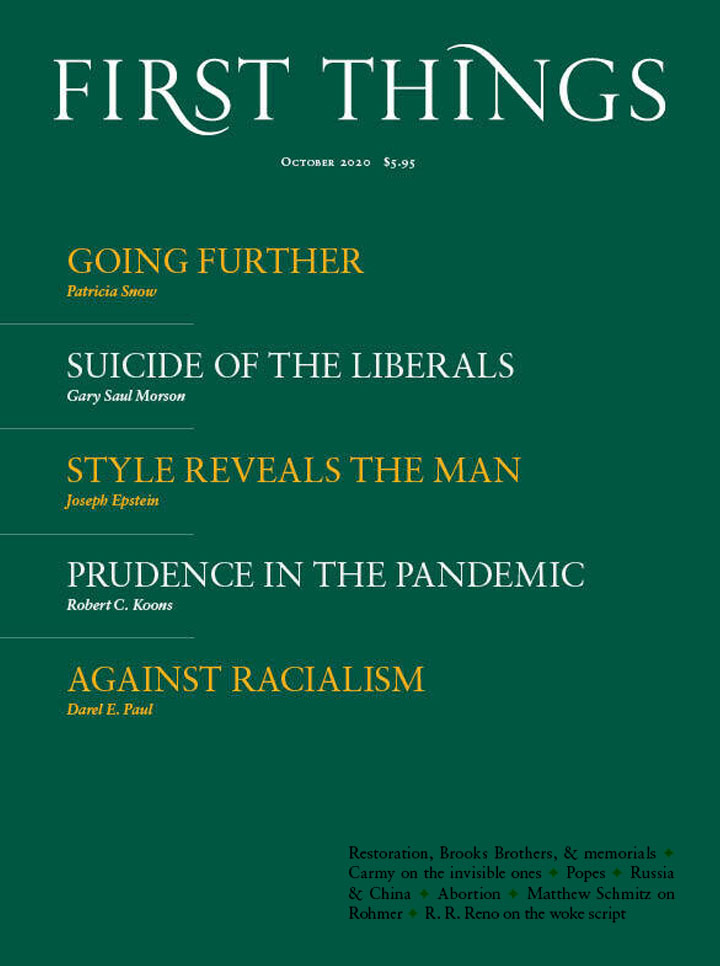What Éric Rohmer said of one of his characters could be said of him as well: He was committed to “redoing all of Rousseau in reverse.” His films are anti-romantic. They reject romantic notions of liberation and autonomy. They critique the cult of romantic love. They warn against a romantic politics that looks forward to a revolutionary future or back to a lost golden age. In the place of these errors, Rohmer championed a serene classicism: over passion, reason; over liberation, restraint; over fantasy, reality. Against the utopians who despise our imperfect present, he asserted the possibility of finding order and beauty in a world still governed by God.
Rohmer rose to fame with his Six Moral Tales. Made in the 1960s and 1970s, this series of films suggested that even the most beautiful, brilliant, and modern people will find freedom only in fidelity. In each film, a man attached to one woman is drawn to another, then returns to the first. In Love in the Afternoon (1972), the last and most moving entry, the hero nearly consummates an adulterous affair, but instead rushes home to his wife. The reconciled couple enjoys a quiet rapport, more profound by far than the one that existed between the wayward husband and his girlfriend. “Freedom expresses itself by limiting itself,” Rohmer said. The man is most himself when embraced by his family.
Rohmer’s own habits—described in a recent biography—were deliberately conventional. Each weekday he took a run before going to the office, skipped lunch (for reasons of thrift and health), and ate his dinner at home. On Sundays he would take his wife and sons to Mass and a gallery. He claimed that he “had no life,” because “happiness has no history.” This quiet life was protected by Rohmer’s legendary reserve. Though he had definite religious and political views, he rarely made them explicit. His classical and Catholic outlook shaped every aspect of his films, but it was not (as a rule) stated openly.
This Rohmerian discretion was sometimes carried to ironical extremes. Rohmer avoided media and used a nom de plume (his real name was Maurice Scherer), in part to protect his mother from the knowledge that her son had grown up to be that disreputable thing, a director (incidentally, one of the most celebrated in France). Despite the perfect probity of his life, he preferred that Madame Scherer go to her grave believing her son was a schoolteacher. Nothing could be more unlike the spirit of self-disclosure in Rousseau’s Confessions.
If the Six Moral Tales commend restraint, Rohmer’s second great series of films, the Comedies and Proverbs, commend reality, and propose the necessity of disillusionment. The men we see as white knights, the women we regard as unblemished damsels, are in fact erring humans. In The Aviator’s Wife (1981), a woman dreams of an ex-lover who will one day knock on her door and “carry [her] off like Prince Charming.” She is, of course, disappointed. Likewise, the heroine of Boyfriends and Girlfriends (1987) realizes that the man she idolized “wasn’t a person but an image . . . a childish dream.” Classicism—the creed of reason, restraint, and reality—means abandoning fantasy.
Rohmer’s most shocking tale of disillusionment is The Marquise of O (1976). Based on a novella by Heinrich von Kleist, set in Italy during the Napoleonic wars, it tells the story of a young marquise who is nearly raped during an attack on her father’s garrison but is saved at the last moment by a high-born Russian soldier. Descending from above, ringed by light, he falls on her attackers like an avenging angel. But later that night, when she is in a swoon, he does what the other men tried to do.
When she revives, she is unaware of what has been done. The marquise reveres the Russian soldier as “the one man above suspicion.” When he confesses his crime, she is shocked. She regards him as Satan incarnate, a creature beyond redemption. Only at the film’s end does she see him for what he is: a man capable of both evil and repentance. “I would never have thought you a devil,” she tells him, “if you had not seemed an angel when I first saw you.” After an extraordinary reconciliation, they enter into a long and happy marriage. Their story demonstrates in extreme, even offensive, terms that romantic illusions are incompatible with love.
Romanticism is most dangerous when it encourages utopian dreams. In The Lady and the Duke (2001), a film about the French Revolution, Rohmer shows how revolutionary visions end in blood. The film’s heroine, a Scottish noblewoman living in Paris, is accosted by a mob of republicans who have placed the head of her friend, a princess, on a stick. She warns her former lover, the Duke of Orléans: “You thought you’d lead the Revolution, but it is leading you where you never wanted to go.”
Rohmer also rejected the romantic hearkening to past utopias, the conceit that civilization and beauty are out of reach in modernity. In Changing Landscapes (1964), a television documentary, he urges viewers to “put aside all the poetic glamour of the invented tradition.” Showing an old windmill, he reminds his viewers that these romanticized structures were built for practical purposes. He then cuts to a backhoe digging a trench. He praises this machine for “the fascination it evokes, the dreams it creates, the methodical beauty it possesses.” Rohmer sought to uphold “tradition in its contemporary aspects.” Even in “a world dedicated to chaos, to the undefined, to perpetual change, to the uncompleted,” he believed beauty was possible. Surveying an industrial zone, he took joy in the way pipes, smokestacks, and structural beams created “contrasts, relations, rhythms, rhymes, and parallelism.” The world has not been, as reactionary romantics like to say, “disenchanted.” It is as charged with glory as it has ever been.
Rohmer’s classicism rested upon his Catholic belief. He rejected utopianism because it despaired of God’s continuing providence. “Everything is fortuitous except chance,” he said. Seemingly random events in fact reflect the work of a higher intelligence. Nor is this presence cold and distant. Time and again in his films, acts that might seem unforgivable are washed away by an overflowing benevolence. Two women who poached each other’s boyfriends are restored to friendship at the end of Boyfriends and Girlfriends (1987). The wayward husband returns in Love in the Afternoon. A happy marriage arises from an unspeakable crime in The Marquise of O.
A Tale of Winter (1992) is the most direct statement of Rohmer’s faith. Its heroine has lost touch with the father of her child but is confident she will be reunited with him. Sensible friends warn her that this is foolishness. They urge her to make a practical marriage with one of the men around her. From their perspective, she is attached to the same sort of romantic ideal that misleads so many other Rohmer characters. But this time there is a crucial difference. The woman lives and acts by faith—not in her unique self, nor in a revolutionary future, but in God’s providence. Her faith is rewarded in one of the most powerful sequences in all of Rohmer’s films.
Rohmer once observed that understanding Alfred Hitchcock requires setting aside terms like tracking, framing, and lenses—“the atrocious jargon of film”—and instead using terms such as “soul, God, devil, . . . redemption, and sin.” The same is true of Rohmer. Each of his films reflects his ultimately religious vision. In a world filled with chaos, he discovered beauty. Among erotic and moral follies, he found contrasts, rhythms, rhymes, and parallels. His camera discerned an order sustained by a benevolent God. Rohmer was an anti-romantic. He was also a poet of providence.
Matthew Schmitz is senior editor of First Things.
The Bible Throughout the Ages
The latest installment of an ongoing interview series with contributing editor Mark Bauerlein. Bruce Gordon joins in…
Redemption Before Christ
The latest installment of an ongoing interview series with contributing editor Mark Bauerlein. Gerald R. McDermott joins…
The Theology of Music
Élisabeth-Paule Labat (1897–1975) was an accomplished pianist and composer when she entered the abbey of Saint-Michel de…



